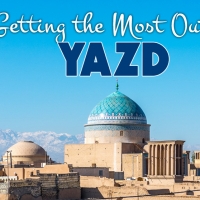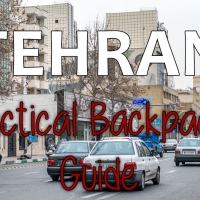- Best of Iran: The Perfect 15-Day Itinerary For Your Life-Changing Trip
- Essential Guide to Applying for an Iranian Visa
- Surviving Tehran: A Practical Backpacker’s Guide
- Visiting Tochal: A Mountain That Looms Over Tehran
- 4 Local Restaurants You Have to Try in Tehran, Iran
- 24 Hours in Tehran: Through the Eyes of Locals
- 5 Great Places to Explore in Tehran, Iran
- Yazd: How to Get the Most Out of Your Visit to an Iranian Tatooine (with useful tips!)
- A Day Trip to Abyaneh: Iran’s Most Beautiful Ancient Village
- Exploring Iran’s Persepolis & Necropolis: The Impressive Legacy of the Achaemenid Empire
- Kerman’s Hidden Gems: Guide to Visiting Rayen, Kaluts, Mahan, and Kerman City
- Plan Your Visit to Kerman, Kaluts, Mahan, Rayen, and Bam – with useful tips!
When I travelled to Iran in 2011, only a handful of nationalities were able to enter Iran. The situation has changed since then and some of the restrictions were lifted to support the booming of Iranian tourism industry. For people from certain nationalities, getting an Iranian tourist visa can still be a confusing and daunting task. So I am going to share my experience applying for a visa on arrival during my visit in 2017 and some of the things I learnt when researching about applying for a visa in advance. Hopefully, this guide helps you to prepare your trip to this beautiful country!
Who can get the visa?
Good news for everyone: nationals of 190 countries can now obtain an Iranian visa on arrival for a maximum stay of 30 days (extendable). There are some countries in the exception, though. The notable ones include Afghanistan, Bangladesh, Canada, Colombia, India, Iraq, Jordan, Nepal, Pakistan, Somalia, Sri Lanka, United Kingdom, and the United States of America. Citizens of these countries are required to apply for a visa in advance before going to Iran.
As a reciprocal measure to the Trump ban for Iranians, citizens of the USA are banned from visiting Iran, as of February 2017. The ban for the US citizens travelling to Iran will be in place as long as the Trump ban is put in place.
One thing to note that, if you have an Israeli passport or an Israeli stamp in your passport, you will be refused from entering Iran.
Travellers from the following countries can visit Iran without a visa for a certain period of stay:
- Armenia – 90 days within 180 days
- Azerbaijan – 2 weeks
- Bolivia – 30 days
- Egypt – 20 days (source)
- Georgia – 45 days
- Lebanon – ? days (source)
- Malaysia – 15 days
- Syria – 90 days within 180 days
- Turkey – 3 months
- Venezuela – 15 days
Visa in Advance vs Visa on Arrival: Which one should I get?

If your country is one of the countries that are eligible for visa on arrival, I would strongly suggest taking that advantage! After two times travelling to Iran, I can conclude that a visa on arrival is the easiest way to get to Iran. For this type of visa, you do not need to prepare so many documents compared to applying for a visa in advance. You also do not need to trouble yourself to visit an Iranian embassy/consulate where you reside. Sure, you may need to wait longer in the airport (depending on the number of tourists applying for the visa on arrival at the same time), but the hassle and costs of applying for a visa in advance outweigh the benefits of getting a visa on arrival. So don’t complicate yourself and take advantage of that visa on arrival 🙂 . Read more on the visa on arrival in the section below.
The visa on arrival option may not be suitable for you if either one of these applies:
- You don’t want to queue at the airport – which takes about 1 hour or more, depending on the number of tourists applying for the visa at the same time – or if you are in a hurry and would like to catch a bus or train to another city quickly
- You are part of an army or you are a journalist, even if you are planning to visit Iran as a tourist. You don’t want your visa to be unexpectedly rejected at the airport, do you?
- Your entry point to Iran is NOT one of these major airports. If you are planning to enter Iran through a land border, it is better to apply for a visa in advance. There are some reports that this was possible, but officially it is not.
- You are a national of one of the countries excluded from the visa on arrival list
Visa in Advance
If you are a national of one of the countries excluded from the visa on arrival list, however, you do not have any choice but to apply for a visa in advance. In order to apply for this visa, an authorization number issued by the Ministry of Foreign Affairs is necessary. Some embassies may still accept visa application without the authorization number, so it is better to check with the embassy of the country you are applying in. Using this method, you may be able to avoid the extra processing fees.
For citizens of Canada and the UK, it is required to be accompanied by a government approved guides and have an exact booked itinerary for their stay in Iran.
Officially, there are two ways to get the visa authorization number: using the official portal or via an approved travel agent.
Via Official Portal
Iran’s Ministry of Foreign Affairs has recently launched an official online visa portal for travellers visiting the country. Unfortunately, many travellers reported that the system was full of glitches – either they were not able to submit the application or there was no updates or confirmation about their application. The purpose of this portal seems to be catered for people who are eligible for a visa on arrival to get it pre-approved prior to arrival, but there are some conflicting reports that it’s for nationals who are not eligible for visa on arrival as well. Up until this point, I have no concrete proof of what the portal is used for.
I am hoping that the portal is improved over the coming months, as travellers can avoid the extra processing costs which are incurred by travel agencies. I will update this space with most recent information and do let me know via the comment box below if there are any updates to this.
Via Travel Agencies
Applying for a visa through a travel agent is possible and it costs around USD 35 – 50 extra (or even more!), depending on nationality and embassy pickup location. The fee is charged on top of the visa fees that need to be paid. There are a number of travel agencies that are available online, but be sure to choose the reliable ones to avoid delays and disappointments. Read some reviews before confirming and making payments. There are a number of blog posts and forums online (like here and here) that mention about IranianVisa being a scam or having a horrible customer service, so do avoid this agency at all cost.
There are a number of travel agencies that are able to help you with the visa process. Some of them are:
- Caravanistan (processing fee: USD 35)
- Touran Zamin (processing fee: starting from 35 euro). You can read this blog post on the whole experience with Touran Zamin
Visa on Arrival
Nationals of 190 countries (meaning almost all countries, with some exceptions – see above) can obtain an Iranian visa on arrival for a maximum stay of 30 days (extendable) at the following major airports:
- Esfahan International Airport (IFN), Esfahan
- Imam Khomeini International Airport (IKA), Tehran
- Kish International Airport (KIH), Kish Island
- Mashhad International Airport (MHD), Mashhad
- Qeshm International Airport (GSM), Qeshm Island
- Shiraz International Airport (SYZ), Shiraz
- Tabriz International Airport (TBZ), Tabriz
There are some reports that Tehran’s Mehrabad airport issues a visa on arrival, but according to this, it’s still being planned.

Lucky for my husband and I, both of us were able to get the visa on arrival. I went to Iran in 2011 and came back again for the second time in January 2017. In both occasions, I took the visa on arrival and I found that the process was hassle-free.
Steps to Apply for Visa on Arrival
Here are the steps to apply for the visa on arrival upon arriving in one of Iran’s major airports. These steps are based on my experience applying for the visa at the Imam Khomeini International Airport, Tehran, so it could be a little different in other airports (but the general idea is the same):
- Go to the insurance desk located nearby the visa section to apply and pay for a travel insurance (read below for more information about this)
- Go to the visa desk and queue.
- Tell the visa officer that you are applying for a visa on arrival for x number of days
- He will check if you have the travel insurance ready. If you have your own travel insurance bought from overseas, then verify it to him that this insurance is accepted
- You will be given a form to fill in and a piece of paper with the cost of the visa on arrival. The fees differ from one country to another and they may change without further notice. So the visa officer is the one who makes sure you pay the right amount
- Go to the bank (next to the visa section) and pay the visa fees. You will be given a receipt of payment
- Go back to the visa desk and bring all the documents (see below on the list of documents).
- Wait until your name is called again. It took us around 1.5 hours to get the visa, due to the long queue.
Requirements for a Visa On Arrival
 Ensure that you have some of these requirements fulfilled before stepping into the country:
Ensure that you have some of these requirements fulfilled before stepping into the country:
- A confirmed return flight ticket
- A valid passport with at least 6 months validity. The passport must NOT contain Israeli visa/stamps.
- Receipt of visa payment paid in USD/Euro only. The fee varies between countries. See below for more information
- Completed visa form, available at the visa desk
- Contact person and phone number of an accommodation or a sponsor in Iran. Please read the do’s and don’ts, which can be found below.
- Travel insurance. See below for more details.
* Passport photo used to be required when I applied for a visa on arrival in 2011, but it was no longer asked when I came back in late January 2017.
Visa Fees
The fees for the visa on arrival vary between countries and the amount may change every year. When we were there in 2017, a Chinese national had to pay EUR 100! Very expensive, isn’t it? As an Indonesian, I had to pay EUR 45 and my husband, who is a Malaysian, had to pay EUR 10 only as we planned to stay for more than 15 days.
You can pay either in Euros or US Dollars, so make sure you have either one of these currencies ready before coming to Iran!
Iranian Contact Person
When filling up the visa form, provided by the visa officer, visitors to Iran are required to provide contact information of a sponsor in Iran. This could be in a form of a person (friend or family), a company, or a hotel/accommodation. Ensure that the phone number is contactable and your sponsor is aware of this, as the visa officer will need to contact your sponsor to verify.
If you are CouchSurfing in Iran, I would strongly recommend NOT to give the contact details of your host to the visa officers, especially if you do it without his/her consent. If anything happens to you when you travel around Iran, your host will be fully responsible. I do think that we should not add more burden to the host! The visa officer will contact your host and ask several questions before the visa is issued to you. If you are travelling alone and your CouchSurfing host/friend is a guy (and he agrees to be your sponsor), then the visa officers will certainly question him as it is culturally not accepted to have a guy staying with a girl (although this happens quite often in Iran these days). Lastly, do NOT even mention about CouchSurfing to the visa officers. Most people know about it, but it quite discouraged by the government and tour operators.
If you are planning to couch surf in Iran, the easiest way to get a sponsor is to book an accommodation for one night and request for a confirmation letter from the hotel. The confirmation can be in the form of email, which contains the full address and contact number of the accommodation where you are going to stay at. This confirmation letter may not be needed anyway, but it could be useful if the officer can’t get in contact with the accommodation (sh*t happens, right?!).
Travel Insurance

In order to apply for a visa on arrival, a valid travel insurance is necessary. As soon as you arrive in one of the airports, head over to the insurance desk to apply and pay for the travel insurance. The cost for the travel insurance for all nationalities is 14 Euros. The coverage starts from the date of arrival (as indicated in your passport) and it is valid for 31 days.
The insurance policy covers the following items:
- Payment of medical, surgical, and poisoning treatment costs
- Transfer and admission to the nearest hospital in Iran
- Repatriation to your country in the event of hospitalisation or death
(!) If you have your own travel insurance, ensure that the policy clearly and specifically states that the insurance covers and valid for Iran. Bring that document with you and go to the visa section to show it to one of the officers. If you fail to do so, then you need to get another travel insurance on the spot.
Visa Extension
It is possible to extend your visa in Iran by its original duration at least once. I never extended the visa so I’d recommend you to check these links out for more information.
How was your experience applying for an Iranian visa? Let me know in the comment box below!




2 Responses
all steps is clear,i would get visa on arrival at shiraz as your advice
thank a lot.
Glad it helps 🙂 hope you can get it through easily!